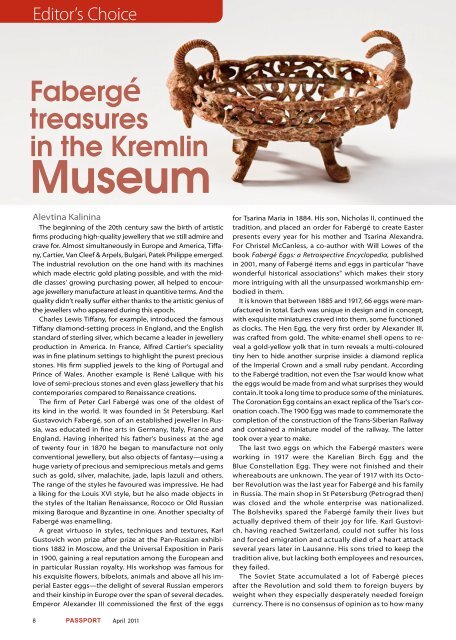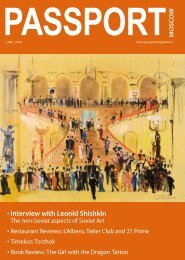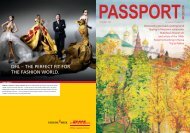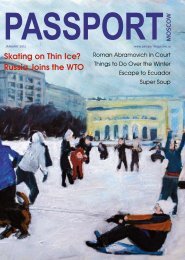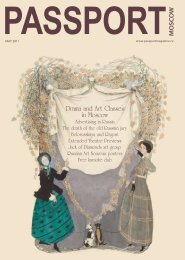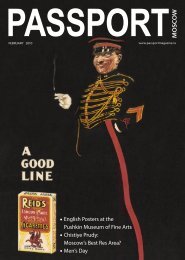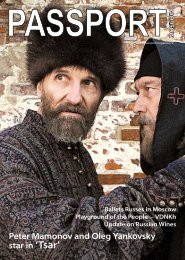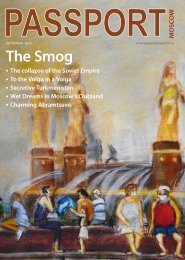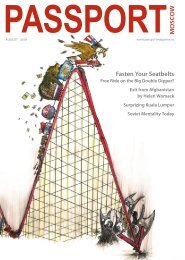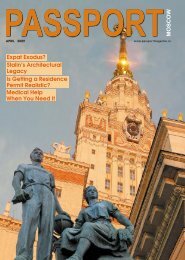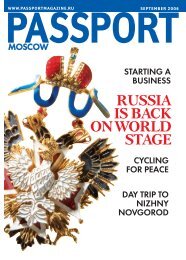Feminism in Russia - Passport magazine
Feminism in Russia - Passport magazine
Feminism in Russia - Passport magazine
Create successful ePaper yourself
Turn your PDF publications into a flip-book with our unique Google optimized e-Paper software.
Editor’s Choice<br />
Fabergé<br />
treasures<br />
<strong>in</strong> the Kreml<strong>in</strong><br />
Museum<br />
Alevt<strong>in</strong>a Kal<strong>in</strong><strong>in</strong>a<br />
The beg<strong>in</strong>n<strong>in</strong>g of the 20th century saw the birth of artistic<br />
firms produc<strong>in</strong>g high-quality jewellery that we still admire and<br />
crave for. Almost simultaneously <strong>in</strong> Europe and America, Tiffany,<br />
Cartier, Van Cleef & Arpels, Bulgari, Patek Philippe emerged.<br />
The <strong>in</strong>dustrial revolution on the one hand with its mach<strong>in</strong>es<br />
which made electric gold plat<strong>in</strong>g possible, and with the middle<br />
classes’ grow<strong>in</strong>g purchas<strong>in</strong>g power, all helped to encourage<br />
jewellery manufacture at least <strong>in</strong> quantitive terms. And the<br />
quality didn’t really suffer either thanks to the artistic genius of<br />
the jewellers who appeared dur<strong>in</strong>g this epoch.<br />
Charles Lewis Tiffany, for example, <strong>in</strong>troduced the famous<br />
Tiffany diamond-sett<strong>in</strong>g process <strong>in</strong> England, and the English<br />
standard of sterl<strong>in</strong>g silver, which became a leader <strong>in</strong> jewellery<br />
production <strong>in</strong> America. In France, Alfred Cartier’s speciality<br />
was <strong>in</strong> f<strong>in</strong>e plat<strong>in</strong>um sett<strong>in</strong>gs to highlight the purest precious<br />
stones. His firm supplied jewels to the k<strong>in</strong>g of Portugal and<br />
Pr<strong>in</strong>ce of Wales. Another example is René Lalique with his<br />
love of semi-precious stones and even glass jewellery that his<br />
contemporaries compared to Renaissance creations.<br />
The firm of Peter Carl Fabergé was one of the oldest of<br />
its k<strong>in</strong>d <strong>in</strong> the world. It was founded <strong>in</strong> St Petersburg. Karl<br />
Gustavovich Fabergé, son of an established jeweller <strong>in</strong> <strong>Russia</strong>,<br />
was educated <strong>in</strong> f<strong>in</strong>e arts <strong>in</strong> Germany, Italy, France and<br />
England. Hav<strong>in</strong>g <strong>in</strong>herited his father’s bus<strong>in</strong>ess at the age<br />
of twenty four <strong>in</strong> 1870 he began to manufacture not only<br />
conventional jewellery, but also objects of fantasy—us<strong>in</strong>g a<br />
huge variety of precious and semiprecious metals and gems<br />
such as gold, silver, malachite, jade, lapis lazuli and others.<br />
The range of the styles he favoured was impressive. He had<br />
a lik<strong>in</strong>g for the Louis XVI style, but he also made objects <strong>in</strong><br />
the styles of the Italian Renaissance, Rococo or Old <strong>Russia</strong>n<br />
mix<strong>in</strong>g Baroque and Byzant<strong>in</strong>e <strong>in</strong> one. Another specialty of<br />
Fabergé was enamell<strong>in</strong>g.<br />
A great virtuoso <strong>in</strong> styles, techniques and textures, Karl<br />
Gustovich won prize after prize at the Pan-<strong>Russia</strong>n exhibitions<br />
1882 <strong>in</strong> Moscow, and the Universal Exposition <strong>in</strong> Paris<br />
<strong>in</strong> 1900, ga<strong>in</strong><strong>in</strong>g a real reputation among the European and<br />
<strong>in</strong> particular <strong>Russia</strong>n royalty. His workshop was famous for<br />
his exquisite flowers, bibelots, animals and above all his imperial<br />
Easter eggs—the delight of several <strong>Russia</strong>n emperors<br />
and their k<strong>in</strong>ship <strong>in</strong> Europe over the span of several decades.<br />
Emperor Alexander III commissioned the first of the eggs<br />
April 2011<br />
for Tsar<strong>in</strong>a Maria <strong>in</strong> 1884. His son, Nicholas II, cont<strong>in</strong>ued the<br />
tradition, and placed an order for Fabergé to create Easter<br />
presents every year for his mother and Tsar<strong>in</strong>a Alexandra.<br />
For Christel McCanless, a co-author with Will Lowes of the<br />
book Fabergé Eggs: a Retrospective Encyclopedia, published<br />
<strong>in</strong> 2001, many of Fabergé items and eggs <strong>in</strong> particular “have<br />
wonderful historical associations” which makes their story<br />
more <strong>in</strong>trigu<strong>in</strong>g with all the unsurpassed workmanship embodied<br />
<strong>in</strong> them.<br />
It is known that between 1885 and 1917, 66 eggs were manufactured<br />
<strong>in</strong> total. Each was unique <strong>in</strong> design and <strong>in</strong> concept,<br />
with exquisite m<strong>in</strong>iatures craved <strong>in</strong>to them, some functioned<br />
as clocks. The Hen Egg, the very first order by Alexander III,<br />
was crafted from gold. The white-enamel shell opens to reveal<br />
a gold-yellow yolk that <strong>in</strong> turn reveals a multi-coloured<br />
t<strong>in</strong>y hen to hide another surprise <strong>in</strong>side: a diamond replica<br />
of the Imperial Crown and a small ruby pendant. Accord<strong>in</strong>g<br />
to the Fabergé tradition, not even the Tsar would know what<br />
the eggs would be made from and what surprises they would<br />
conta<strong>in</strong>. It took a long time to produce some of the m<strong>in</strong>iatures.<br />
The Coronation Egg conta<strong>in</strong>s an exact replica of the Tsar’s coronation<br />
coach. The 1900 Egg was made to commemorate the<br />
completion of the construction of the Trans-Siberian Railway<br />
and conta<strong>in</strong>ed a m<strong>in</strong>iature model of the railway. The latter<br />
took over a year to make.<br />
The last two eggs on which the Fabergé masters were<br />
work<strong>in</strong>g <strong>in</strong> 1917 were the Karelian Birch Egg and the<br />
Blue Constellation Egg. They were not f<strong>in</strong>ished and their<br />
whereabouts are unknown. The year of 1917 with its October<br />
Revolution was the last year for Fabergé and his family<br />
<strong>in</strong> <strong>Russia</strong>. The ma<strong>in</strong> shop <strong>in</strong> St Petersburg (Petrograd then)<br />
was closed and the whole enterprise was nationalized.<br />
The Bolsheviks spared the Fabergé family their lives but<br />
actually deprived them of their joy for life. Karl Gustovich,<br />
hav<strong>in</strong>g reached Switzerland, could not suffer his loss<br />
and forced emigration and actually died of a heart attack<br />
several years later <strong>in</strong> Lausanne. His sons tried to keep the<br />
tradition alive, but lack<strong>in</strong>g both employees and resources,<br />
they failed.<br />
The Soviet State accumulated a lot of Fabergé pieces<br />
after the Revolution and sold them to foreign buyers by<br />
weight when they especially desperately needed foreign<br />
currency. There is no consensus of op<strong>in</strong>ion as to how many


